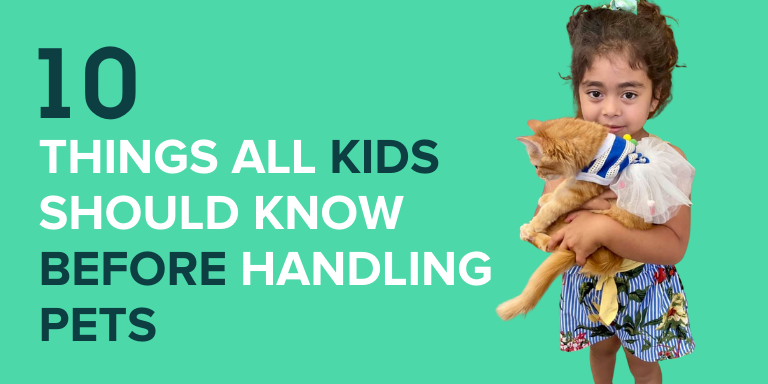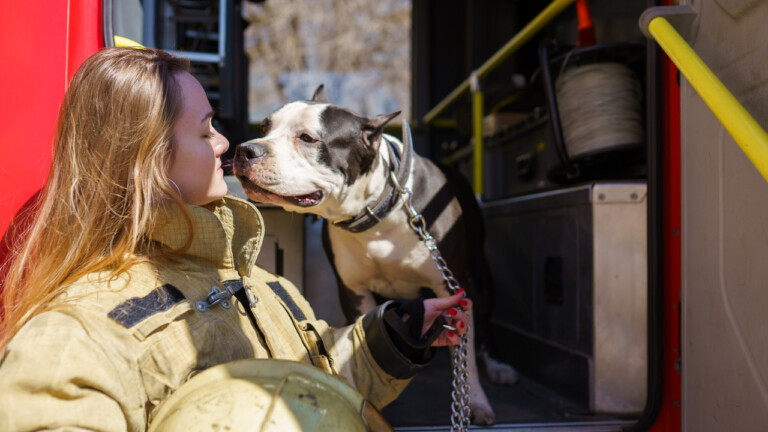Physically handling pets can be a delicate process, whether they’re small and fragile or big and friendly. All pets deserve respect and personal space. Improper handling can lead pets who are otherwise obedient to display signs of aggression and stress, including growling/hissing, scratching, or even biting.
Children often struggle with understanding boundaries with animals, which is why it is so important to educate our kids on how to safely handle pets. So, let’s talk about some steps that parents can take to help make animal interactions safe and fun for both the pets and the kiddos!
#1 Everyone – Especially Pets – Deserves Boundaries
No matter how sweet the pet may be, they can eventually become frustrated with a child that continues to invade their space. Even if they are not doing anything necessarily painful, the pet may lash out in order to say, “Hey, leave me alone.” Pets cannot use words to communicate, so they rely on avoidance (walking away), warnings (growling or hissing), or self-defense behaviors (biting, scratching, etc.) to indicate that they are uncomfortable. Each pet is unique in how quickly they progress from one stage to another, but every pet has a limit after which they may bite or otherwise injure someone!
As a parent, it is your job to teach your child to give animals space, especially if the pet is giving clear indications that they would like to be left alone. Young children should NEVER be left unattended with pets because there is a risk of injury (or in extreme cases, death) to both the pet and the child.
Always supervise your child around animals, even dogs and cats that appear to be friendly, until you know that your child understands the pet’s boundaries and body language.
#2 Show Them How To Properly Pet And Hold An Animal
Using a flat hand to pet something doesn’t always come naturally to children and the younger they are, the more likely they are to grab and pull out hair. It is crucial that we teach kids how to properly pet an animal, and that technique depends on the species.
Practicing petting with a flat hand on a stuffed animal can be a great way to teach safe habits. Holding or carrying a pet is a completely different story and it would be best to not allow young children to pick up and hold an animal, even a dog or cat. Children do not always have the muscle control required to support an animal that is close to their own size/weight! It is often uncomfortable and awkward for the animal and could potentially lead to accidental injury on either side. Wait until your child is old enough to comfortably support an animal before allowing them to pick them up.
#3 Not Every Animal Is Friendly
When kids have only been around friendly dogs and cats, they have a false sense of security when approaching new pets in uncontrolled situations. Teach your kids that just like people, animals have different personalities, and some may be scared or distrustful of strangers.
#4 Ask The Owner Before Touching
Many people walk their dogs in public places, and in a lot of cases they are totally fine with strangers asking to pet their dog. However, not every dog wants to be pet while they’re out in public (remember: dogs have boundaries!). Children (and adults!) need to know that they should always ask the owner for permission before touching or approaching another person’s pet.
Even if the dog is wagging its tail happily, they may be a service dog or one that is in training and should not be touched without the owner’s permission. A friendly dog may also have preferences in terms of where or how they are pet. And finally, it’s just good manners to ask first!
#5 Teach Basic Body Language
In most situations, a dog is going to tell you before anything happens that they are uncomfortable or unhappy, and they do so with their body language. Teaching a child to identify potentially dangerous or tell-tale signs of a dog saying, “Don’t come near me,” can save everyone a major scare.
A dog may be uncomfortable or unhappy if they are:
- Tucking their tail between the legs
- Cowering or hunching
- Baring teeth or snarling
- Pinning ears back
- Widening eyes
- Hiding or avoiding contact
- Growling
With cats, body language can be a little different. Leave the cat alone if they are:
- Hissing
- Arching their back
- Has its ears flat against their head
- Cowering
These signs are not always easy to explain, especially to young children. If a pet seems to be warning your kid and they are not giving them space, then it would be best to remove them from the situation.
#6 Do Not Take Food Or Toys Away From A Pet
This is especially true with dogs as they can become defensive or protective of things like food and toys. In general, it is good practice to teach your child to never take these items from any dog, even one they are familiar with, as they could be bitten. Even if your dog does not guard its food or toys, it may think that the child is trying to start a game of tug-of-war, and it could inadvertently bite or harm your child.
If they see that their dog has something in their mouth that they shouldn’t, then they need to get an adult for assistance.
#7 Teach Your Child How To Make A Proper Introduction
It’s always best to allow an animal to sniff you before initiating any kind of physical contact. With children, this is an especially important aspect of pet handling.
Approaching an animal slowly is good practice as it is less startling. No matter how excited they are, they need to use a calm voice and gentle hand when first interacting with a strange pet (and even familiar ones). Remember, establishing boundaries with animals is important!
The next step is allowing the animal to smell from a short distance. You should NOT shove your hand in the dog or cat’s face to “let it sniff.” Instead, hold your hand gently toward the front of your body and allow the pet to approach and sniff it. If the pet shies away or gives any other indication that it isn’t comfortable, then standing still or walking away calmly is the safest option.
#8 Use A Flat Palm When Feeding Treats
Sometimes overzealous animals will get a little excited about a snack and may nip your fingers when taking a treat. For adults, it’s not always a big deal but for little kids, their small fingers are more likely to be injured by an accidental nip.
That’s where teaching the “flat hand” technique for feeding treats comes in.
It’s pretty simple: have your child hold out an open hand and let the animal take the treat from their palm. If your child is really small or your pet gets too excited about treats to take them calmly, teaching your child to toss treats on the floor in front of the animal may be the best option.
#9 Let The Animal Come To You
One of the best ways to get an animal to like you is to allow them to come to you when they are ready. Actively seeking out that pet’s attention often makes them want to avoid that person.
For children, their eagerness to pet and be around an animal often has the opposite effect. This is where teaching them those ultra important boundaries (#1) come in. If the pet wants your attention, then they will come to you when they are ready. If a child wants to get a pet’s attention and play, they can use a toy to get the pet’s attention from afar and allow the pet to approach and investigate.
In general, your child should not be approaching or touching pets when they are sleeping. How would you like it if someone came over and started poking/patting you while you were taking a nap?
#10 Supervise, Supervise, Supervise
Veterinary professionals can’t say it enough: Supervise your children around pets. ESPECIALLY, if your child is very young or inexperienced around animals. Allowing unsupervised access can lead to accidents and injuries to either the child or animal and no one wants that! It takes several months to even years to develop a strong relationship with a new pet, and even then accidents can happen, so keeping an eye on your pet and your child is the safest way to ensure trusting relationships.
Before you go – If you enjoyed this post, you probably love pets as much as we do! Did you know that you can sponsor a pet in need each month with a Nose to Tail Team donation and receive a limited-edition tote bag? Join our Nose to Tail Team and help a pet family get the care they need each month for just $0.54 a day.






